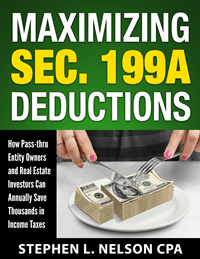You have probably already heard the bad news. Partnership Section 199A deductions get limited or even eliminated in many situations.
If you’re a partner in a partnership or a tax accountant, however, you want to understand the way partnership tax accounting produces this result.
You may have one possible workaround that salvages the deduction. But let’s quickly go through the issues…
And one other note: We have updated this post’s information for the final regulations which appeared on January 18 2019. Just so you know…
Why Partnership Section 199A Deductions Get Hammered
Let’s start with a quick overview of the problem…
Traditional partnership accounting hammers down partner Section 199A deductions for two reasons.
First, Section 199A says guaranteed payments to partners–payments made to partners for services or the use of capital but without regard to partnership income–don’t count as qualified business income.
Second, Section 199A says that Section 707(a) payments, which are payments to a partner for services in a “other than in his capacity as a member of such partnership” also don’t count as qualified business income.
As you probably know if you’re reading this, “qualified business income” matters. Qualified business income plugs into and largely determines some taxpayer’s Section 199A deduction.
The simplest version of the Section 199A deduction formula, for example, calculates the deduction as 20 percent of the qualified business income.
Example: A partner with $125,000 of qualified business income–his or her allocation of the operating profits–potentially receives a $25,000 Section 199A deduction.
Example: A partner who receives $120,000 of guaranteed payments from a partnership and then another $5,000 allocation of leftover partnership profits also receives $125,000 of income from the partnership. But only that $5,000 profit allocation counts as qualified business income, which means potentially only a $1,000 Section 199A deduction.
Many partners and tax accountants learn about the above tax accounting and conclude, darn it, Section 199A won’t work for a partnership. But a potential workaround exists.
Special Allocations Save Partnership Section 199A Deductions
The workaround? A partnership may choose to pay out its profits without using guaranteed payments and instead use what tax law calls Section 704 special allocations.

In other words, the partnership doesn’t pay out profits to partners using some rule that ignores partnership income such as “each working partner receives a guaranteed $10,000 a month no matter what happens in the business.” This arrangement counts as a guaranteed payment.
And a partnership doesn’t allocate profits based on a simple percentage such as “Steve, you own 25 percent of the partnership so the tax return allocates you 25 percent of the partnership’s income.” That turns out to be too inflexible for a partnership of working partners–like a law firm or physicians’ group practice–where partner incomes need to reflect partner contributions.
Instead, the partnership allocates its profit using some different, more complex formula documented in the partnership agreement and based on the income of the partnership and the contributions of the partner.
An Example Special Allocation
A professional services firm, for example, might allocate partnership income based on the revenue production of the partner. Or on the marketing she or he does for the firm–which doesn’t generate direct profits but aids the firm in its marketing. (What if the partner writes a tax column for a national business magazine?.)
This approach might mean some partner who previously received (say) $120,000 of guaranteed payments and $30,000 of profit allocation would instead receive $150,000 of profit allocation. And that would mean, in this simple example, that the Section 199A deduction goes from 20 percent of the $30,000 to 20 percent of the $150,000.
The other piece in this puzzle? Partners used to receiving guaranteed payments or Section 707(a) payments probably need to receive advances or draws against the forecasted special allocations they will receive. But that requirement can be met too by formalizing the process of making distributions to partners.
Example: A professional services partnership used to make guaranteed payments equal to $10,000 a month to compensate partners for their contributions and then also another year-end distribution from any additional leftover profit allocation. But the partnership can change this approach. Going forward, the partnership can skip the guaranteed payments, replacing them with regular monthly $10,000 distributions and then also the “usual” year-end distribution.
Replacing $120,000 of guaranteed payments with a combination of special allocations and a regular distribution amount may bump up the Section 199A deduction partners enjoy by $24,000.
Understanding Section 704 Special Allocation Rules
This short blog post can’t cover the pretty complicated rules set out in the Section 704 regulations as to how special allocations need to work. But two comments to put practitioners and taxpayers on the path to considering the “special allocation” work around.
A first point: Special allocations allow taxpayers to engage in all sorts of smoke-and-mirrors tomfoolery that reduces the income taxes individuals pay.
A partnership might use special allocations which serve no purpose other than minimizing partner tax burdens, for example.
One wouldn’t need to think too long, for example, to come up with an idea to allocate qualified business income to partners who may get a Section 199A deduction (like individuals) and then allocate non-qualified business income to partners who won’t get the deduction (like corporations). But that doesn’t work.
Predictably, the Section 704 regulations, specifically Regulation 1.704-1(b), say the allocations of partnership income, deductions, credits and so forth need to reflect economic substance.
Anyway, that’s the first thing to understand.
And then a second point–which bears consideration. The amounts partnerships have sometimes called guaranteed payments haven’t really always been true guaranteed payments.
No, no, don’t worry. Using guaranteed payments to compensate owners for their production works. The IRS never cared.
But guaranteed payments should equal the payments a partnership pays partners regardless of the partnership’s income. And many times the guaranteed payments don’t really work this way.
Partnerships may use guaranteed payments not because those amounts are truly independent of partnership income. Rather, the partnership uses guaranteed payments because they provide a simple way to share fairly part of the profits.
The point here: Guaranteed payments in some cases have simply provided a way to avoid more sophisticated special allocations.
Two Final Comments
First, if you’re in a partnership, talk with your tax accountant. Maybe you can bump your Section 199A deductions by tweaking the partnership agreement to create more qualified business income.
You may not be able to get this result. But not paying taxes on that last 20 percent of your partnership income is too big a benefit to ignore. Seriously, invest some time and money exploring this option.
Second, if you’re an accountant, let me encourage you do your analysis very carefully. No quick telephone consultations or informal email discussions, in other words. This stuff gets too tricky.
Maybe review again the proposed regulations’ rules for partnership Section 707(c) guaranteed payments and Section 707(a) payments.
You probably want to at least glance over again the discussion and examples in Regulation 1.199A-5(d)(3)(ii) which talk about when someone isn’t really a partner for purposes of Section 199A. (This lets you channel the logic of Congress and the Treasury.)
And probably you want to review Regulation 1.704-1 so that discussion sits fresh in your mind.
Note: The classic little partnership tax accounting book, The Logic of Subchapter K also provides a great discussion of what “economic substance” means. Practitioners who want to brush up on the Section 704 regulations may want to read that book (especially Chapter 5.)
One final hunch to mention? In theory, the special allocation approach should work in many situations. In practice, many partnerships just won’t be able to either do the accounting or edit the partnership agreement. But every partnership should at least look at the option.
Other Free Section 199A Resources
We’ve also published and keep up-to-date a number of other Section 199A blog posts, too. If you’re learning the law, these can be useful free resources.
Real Estate Broker Section 199A Deductions
Section 199A Trade or Business Concept Deconstructed
Section 199A Rental Property Trade or Business Definition
S Corporation Section 199A Deduction Connection.
